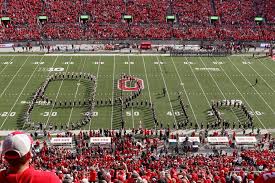Title: Ohio State Implements Cutting-Edge Technology to Shorten Wait Times for Football Game Fans
Ohio State University has long been a premier destination for college football fans, with one of the largest stadiums in the country. However, as the fanbase continues to grow, the challenge of managing the crowd efficiently has never been greater. From long lines at concession stands to crowded restrooms, wait times at Ohio State’s Ohio Stadium (The Horseshoe) have historically been a significant concern. However, thanks to technological innovation, these wait times are becoming a thing of the past. By integrating cutting-edge technology from SBJ Tech and WaitTime, the university is ensuring that its fans can spend more time enjoying the game and less time standing in line.
The Challenge: Long Wait Times at Large Venues
Ohio Stadium, home to the Ohio State Buckeyes, can hold more than 100,000 fans on game day. With such large crowds, managing the flow of people becomes a critical issue. Fans often find themselves waiting in long lines for food, drinks, and restroom facilities. The experience of standing in long lines can detract from the excitement of attending a live football game, especially when the action on the field is so fast-paced and thrilling.
The sheer volume of people on game day makes it nearly impossible to avoid these challenges without a solid plan in place. In the past, Ohio State’s response to managing crowds primarily revolved around increasing the number of concessions and restroom facilities available. While this helped alleviate some pressure, it was still not enough to eliminate wait times altogether.
A Technological Solution: WaitTime and Crowd Intelligence
To tackle these issues, Ohio State University partnered with SBJ Tech and WaitTime, a company that uses real-time crowd intelligence to analyze crowd movement and predict wait times. WaitTime’s technology uses a network of cameras installed around the stadium to monitor crowd behavior and track the flow of people in various areas, including concession stands and restrooms.
WaitTime’s system utilizes artificial intelligence to analyze the data captured by these cameras. The AI-powered technology can predict how long it will take for fans to move through the lines based on historical data, current conditions, and real-time observations. This information is then made available to fans via the official Ohio State Buckeyes app, allowing them to check wait times for concessions and restrooms before heading to a particular location. By giving fans the tools they need to make informed decisions, Ohio State aims to streamline the game day experience and improve overall fan satisfaction.
The Rollout: Integrating WaitTime at Ohio Stadium
In 2023, Ohio State began using WaitTime’s technology to monitor crowd behavior and predict wait times. By 2024, the technology was fully integrated into Ohio State’s official mobile app, giving fans easy access to real-time data about wait times. The app’s integration with WaitTime provides an intuitive user experience, allowing fans to check line lengths and avoid the busiest areas of the stadium.
Approximately 100 cameras were installed around Ohio Stadium, covering high-traffic areas such as restrooms and food stands. The cameras continuously feed data to WaitTime’s system, where it is analyzed and processed. The information is then displayed on the Buckeyes app, which is available to both iOS and Android users.
By integrating this technology into the stadium’s operations, Ohio State has significantly reduced the time fans spend in line, enhancing their overall experience. Whether it’s purchasing a snack or using the restroom, fans now have the option to choose the least crowded areas, avoiding frustrating delays. The result is a more enjoyable and efficient game day.
Results So Far: Fans’ Response to WaitTime
Since the integration of WaitTime’s system, Ohio State has received positive feedback from fans. Surveys conducted after games have shown that those who used the app to check wait times reported greater satisfaction with their overall experience. Fans noted that they were able to maximize their time at the game, spending less time standing in line and more time enjoying the action on the field.
For example, one fan reported that by using the app, they were able to avoid a long line at a popular concession stand by heading to a nearby stand with a much shorter wait. Others appreciated the ability to see real-time data about restroom wait times, allowing them to plan their trips to the restroom during breaks in the game.
The positive reception from fans highlights the value of WaitTime’s technology in enhancing the overall game day experience. Fans no longer feel as though they are missing out on key moments of the game due to lengthy waits for food or restrooms. This improved fan experience is crucial for universities like Ohio State, which are constantly striving to keep fans engaged and satisfied.
Behind the Scenes: How WaitTime’s Technology Works
The magic of WaitTime’s system lies in its use of artificial intelligence and machine learning to process large amounts of crowd data in real time. By analyzing patterns in crowd movement, WaitTime can predict where bottlenecks are likely to form and estimate how long fans will need to wait to get through certain areas. This data is continuously updated, providing fans with the most accurate and up-to-date information.
WaitTime’s technology goes beyond just measuring wait times. It also tracks the speed at which lines are moving, which helps to identify areas of the stadium that may need more resources or attention. For example, if a certain concession stand is experiencing an unusually high volume of foot traffic, the system can alert stadium operators to send more staff to that area, further improving wait times.
The cameras used in WaitTime’s system are strategically placed throughout the stadium to capture comprehensive crowd data. These cameras are designed to work in various lighting conditions and can track the movement of individuals within large groups. The use of AI to process the data ensures that the system can adapt to changing conditions, such as fluctuations in crowd size or shifting traffic patterns.
The Future of Fan Engagement at Ohio State
The successful implementation of WaitTime at Ohio Stadium is just the beginning. Ohio State plans to expand the use of this technology in the future, looking for additional ways to improve fan experience on game day. One potential avenue for expansion is the integration of WaitTime’s data into the stadium’s broader operational systems. For example, if a restroom is experiencing high traffic, the data could trigger an alert for cleaning crews to attend to that area, ensuring that facilities remain clean and hygienic for fans.
Moreover, as more fans become aware of the app’s capabilities, Ohio State aims to increase its usage, ensuring that as many people as possible benefit from the real-time data. Marketing campaigns and educational initiatives may be rolled out to encourage fans to use the app, especially those who are less familiar with digital tools.
Ohio State is also exploring the possibility of integrating additional features into the app. For instance, the university is looking into the idea of offering mobile ordering for concessions, allowing fans to place orders ahead of time and pick them up at designated spots without having to wait in line. This would further streamline the fan experience, giving fans even more time to enjoy the game.
Setting a New Standard for Sports Venues
The success of Ohio State’s collaboration with WaitTime sets a new standard for fan engagement and operational efficiency in sports venues. The use of AI-driven technology to monitor crowd behavior and manage wait times is an innovation that could soon be adopted by other major stadiums and sports venues across the country. As more and more venues look for ways to enhance the fan experience, Ohio State’s efforts serve as a model for how technology can be leveraged to create smoother, more enjoyable game days.
As the sports industry continues to evolve, technologies like WaitTime will play an increasingly important role in shaping the way fans interact with stadiums. By prioritizing convenience and efficiency, stadiums can ensure that fans remain engaged, satisfied, and eager to return for future events.
Conclusion: A Smarter, More Enjoyable Game Day Experience
In conclusion, Ohio State’s implementation of WaitTime technology represents a significant leap forward in improving the fan experience. By reducing wait times at key areas of the stadium, the university is enhancing the overall game day atmosphere and ensuring that fans have more time to enjoy the game. The success of this initiative highlights the growing role of technology in sports venues and serves as a valuable case study for other institutions looking to improve their own fan engagement strategies. With continued innovation and expansion of these efforts, Ohio State is positioning itself as a leader in the integration of technology and sports entertainment.



